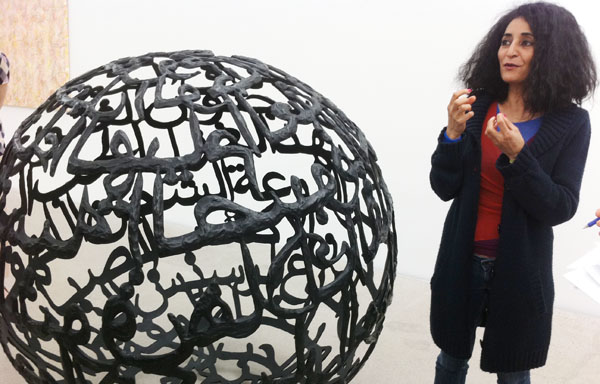An Egyptian’s bold take on women’s issues

Egyptian Artist Ghada Amer explains her 2012 work “The Words I Love the Most,” now on display at Kukje Gallery, on Thursday. By Moon So-young
After more careful observation, shapes of women jumped out one by one. The tangled lines are actually eight women standing shoulder to shoulder. The title of the sculpture is “Blue Bra Girls.” But they are not wearing blue bras.
“When the 2011 Egyptian revolution took place, I saw the images through media in America and, one day, I met the image of a female activist beaten and stripped of her clothes leaving her blue bra exposed through [Twitter],” Amer said. “I was shocked and I could not sleep that night. I decided to make a work to express my homage to this women’s bravery.”
While the woman was forced to fall on the ground, the “Blue Bra Girls” stand straight and look in the eyes of the viewers, the artist added.
Like this, Amer deals with political and feminist issues through “uncompromising craft and mastery of line in both two dimensions and three” according to Kukje. The solo show consists of her sculptures made of metal lines and spaces and her paintings combined with embroidery that look like pen drawings at a distance.
The artist said she talks about women’s issues “not limited to the Middle East region but universal,” pointing out that “women’s conditions in the Middle East are worse than in America or Europe but problems exist also in the latter regions.”
“I don’t like being categorized, but if I should be, I prefer a woman artist [rather] than a Middle East artist,” she continued. “A Middle East artist could sound exclusive [of other regions rather] than inclusive. [On] the other hand, as an artist, I do what interests me, and that’s women, naturally as I’m a woman. I talk about women through women’s mediums.”
Amer’s paintings combined with embroidery, for which she has gained international fame, are also the result of the use of “women’s mediums,” according to the artist.
Still, she also expresses affection toward the culture of Egypt, the country where she was born. This is seen in “The Words I Love the Most,” another sculpture on display. The metal lines making the sculpture are in Arabic and tell of love.
“There are 100 words related with love in the Arabic language,” she said. “But other people tend to associate only violent things with the Arab region. So I have made the work hoping that the region will be associated with love.”
By Moon So-young [symoon@joongang.co.kr]
The show runs through June 30. Admission is free. Hours are 10 a.m. to 6 p.m. Monday to Saturday, and until 5 p.m. Sunday. Go to Anguk Station, line No. 3, exit 1, and walk 10 minutes. For more information, visit www.kukje.org or call (02) 735-8449.










with the Korea JoongAng Daily
To write comments, please log in to one of the accounts.
Standards Board Policy (0/250자)